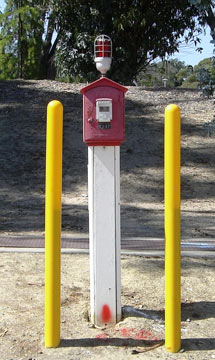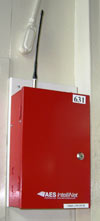
Handy Links
SLAC News Center
SLAC Today
- Subscribe
- Archives: Feb 2006-May 20, 2011
- Archives: May 23, 2011 and later
- Submit Feedback or Story Ideas
- About SLAC Today
SLAC News
Lab News
- Interactions
- Lightsources.org
- ILC NewsLine
- Int'l Science Grid This Week
- Fermilab Today
- Berkeley Lab News
- @brookhaven TODAY
- DOE Pulse
- CERN Courier
- DESY inForm
- US / LHC
SLAC Links
- Emergency
- Safety
- Policy Repository
- Site Entry Form

- Site Maps
- M & O Review
- Computing Status & Calendar
- SLAC Colloquium
- SLACspeak
- SLACspace
- SLAC Logo
- Café Menu
- Flea Market
- Web E-mail
- Marguerite Shuttle
- Discount Commuter Passes
-
Award Reporting Form
- SPIRES
- SciDoc
- Activity Groups
- Library
Stanford
Around the Bay
Trusty Old Fire Alarms Give Way to New Technology
The iconic red fire alarm boxes that have adorned SLAC since its opening day will soon disappear, victims of technological obsolescence. These Gamewell master boxes are part of a telegraphic fire alarm system that has been reporting SLAC fire alarms to emergency responders since 1968.
The technology is old but reliable. When the alarm box is triggered, a spring-loaded, toothed wheel spins and taps out the coded, four-digit box number. The first such system was installed in Boston in 1845. SLAC's version of the technology—known as a McCulloh loop—works so well that the underlying arrangement has remained largely unchanged since it was patented in 1882. It was the predominant institutional fire alarm reporting technology nation-wide well into the 1970s. Due to their ruggedness and reliability, Gamewell systems remain in use in several major U.S. cities, including San Francisco, as the ultimate post-disaster municipal alarm system.
Despite its age, the SLAC Gamewell system continued to perform effectively until early last year, when a segment of the public phone system transmission lines that connect SLAC to Palo Alto Dispatch were changed entirely from copper to fiber optic. Alas, fiber optic lines are incapable of transmitting telegraph signals. After 40 years of faithful service, the Gamewell System abruptly fell silent. As an interim measure, SLAC Security has been manually notifying Palo Alto Dispatch of SLAC Fire Alarms for the last several months via a dedicated emergency red phone located at the Main Gate.
Using Recovery Act funding, SLAC is completing installation of radio transmitters integrated with Stanford University's state-of-the-art fire alarm reporting system. The new transmitters use a highly reliable wireless mesh network radio technology. They are mounted near building fire alarm control panels and transmit alarm information directly from through the University to Palo Alto Emergency Dispatch Center, via a dedicated T-1 data line. The Stanford system can also rapidly notify SLAC Security and other key response personnel of alarms using automated e-mails and text messages.
And as for those iconic red master boxes? The ones in good shape actually do have value as collectible fire service memorabilia, going for tens to hundreds of dollars apiece. A very small number of the boxes will be reserved for official commemorative use at SLAC. The rest will be turned over to SLAC Salvage, which will offer them as excess to other government agencies. Afterward, Salvage will offer any remaining units through an on-line internet auction Web site that is open to the public. Anyone with an idea for a specific official SLAC commemorative use can e-mail SLAC Fire Marshal Ralph Kerwin. Anyone wishing to be informed when the remaining boxes (if any) come up for public bid should send an e-mail to Gus Venancio at Salvage.
—Ralph Kerwin
SLAC Today, July 26, 2010

